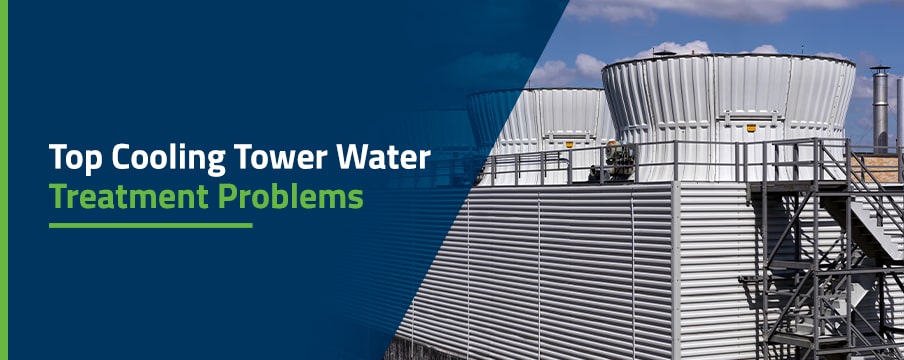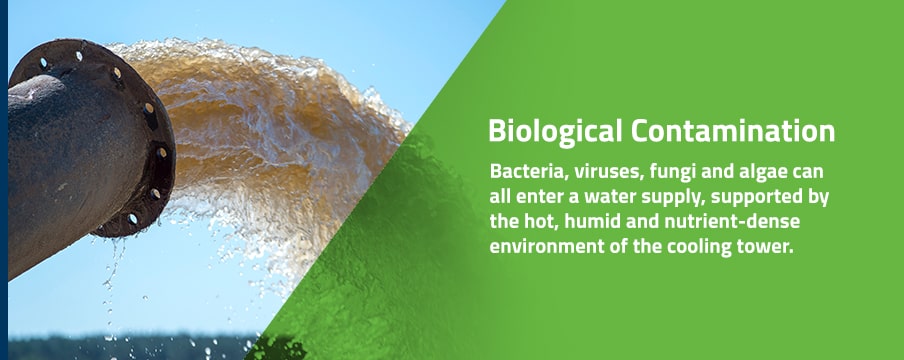
Cooling towers are heat exchangers commonly used to cool large buildings and remove heat built up from industrial processes. These towers use water evaporation to remove waste heat. However, cooling towers can face a range of issues that can result in inefficient cooling or damage. To avoid costly repairs and replacements, facilities need to be aware of the common problems that can occur with cooling towers, especially problems relating to treating the water in the cooling towers.
This article covers common cooling tower problems relating to water treatment and how a cooling tower water treatment specialist can help solve them.

Contamination from biological sources is a common source of issues in cooling towers. Bacteria, viruses, fungi and algae can all enter a water supply, supported by the hot, humid and nutrient-dense environment of the cooling tower. This biological contamination can result in significant problems, depending on the source. Some of the most significant issues include:
A cooling tower water treatment specialist will diagnose biological contamination within a cooling tower by collecting water samples. By analyzing the sample, the specialist will identify the type of contamination in the water and determine the best way to treat the water appropriately. During the treatment process, the specialist will collect more samples for analysis to verify that all contaminants were removed from the system.
Biological contamination is often treated by shocking the cooling tower’s water with chlorine to kill any contaminants before flushing and refilling the tower with fresh water. However, chlorine is a corrosive chemical that can damage cooling tower interiors if used frequently. For this reason, cooling tower water treatment specialists may elect to use different chemicals for treatment and prescribe a consistent treatment plan to help avoid microbiological contamination.
Any water system faces the potential of corrosion. Corrosion is the breakdown of metal and naturally occurs when a metal comes into contact with water. In cooling tower systems, the chance of corrosion is particularly high due to the chemicals used in water treatment and the high concentration of electrolytes in the water due to evaporation. Additionally, water corrosivity increases with high conductivity in cooling tower water since corrosion is an electrochemical process by nature.
Corrosion can cause serious problems in a cooling tower, including:
Because of the potential dangers of corrosion, it is essential to check regularly for corrosion in cooling towers.
A water treatment expert can identify corrosion in a cooling tower system and may treat it in multiple ways. Some treatment options include:
Water treatment specialists will often recommend a combination of options to help protect cooling towers from corrosion.
Scaling is similar to biological buildup, except that it is the buildup of minerals. When these minerals build up, they form thin, plate-like pieces that can attach to surfaces. When scaling occurs, it can cause various problems within cooling towers, including the following:
Scaling can be affected by several factors within the cooling tower environment, such as alkalinity, pH, temperature and the velocity of water movement. However, the most common cause of scaling in a cooling tower is water hardness. Most scaling consists of calcium salts, especially calcium carbonate, which is often present in hard water. Hard water with high levels of calcium causes the water to form scales. This hardness is quantified through water conductivity since calcium is an ionized mineral.
Once scaling is identified within a cooling tower system, it must be removed to bring cooling towers back to operational efficiency.
After scaling is identified, it needs to be removed during cleaning processes to prevent accumulation. However, it is always best to prevent scaling, which can be achieved with certain procedures:
Because cooling towers work through water evaporation, these systems can quickly accumulate high concentrations of chemicals and minerals as the water evaporates. On top of the chemicals and minerals purposefully added to the water, debris from corrosion, scaling and external contaminants can also accumulate within the cooling tower water. The accumulation of these dissolved solids and debris can lead to scaling, corrosion or blockages within the cooling tower system. To prevent these issues, cooling tower operators regularly remove water with high debris and mineral concentrations through a process called “blowdown.”
In a cooling tower blowdown process, an operator removes a portion of the water in a cooling tower and replaces it with fresh makeup water. The operator determines how much blowdown is needed to achieve desired results. However, whenever blowdown occurs, the system removes circulation water and treatment chemicals. With rising water costs and waste management regulations, this can quickly add to a facility’s operational costs.
Operators should monitor their blowdown processes closely, tracking how much blowdown is required in each process. If the tower requires too much blowdown, this can indicate several potential problems:
High cooling tower blowdown can be costly over time, so it is essential to monitor blowdown closely to determine if there is an increase in blowdown needs.
If your cooling tower requires more blowdown than normal, reach out to your cooling tower water treatment expert for analysis and diagnosis. Depending on the source of the problem, they may recommend one or more of the following solutions:
Cycles of concentration are a key parameter for evaluating cooling tower operations. Cycles of concentration is a ratio that measures the concentration of dissolved solids in blowdown water compared to makeup water. High cycles of concentration mean that the concentration of solids in blowdown water is high compared to that of the makeup water. The higher the cycle of concentration, the less blowdown and makeup water is needed, which helps save water and treatment chemicals. Typically, systems should operate at cycles of concentration ranging from three to six, which helps reduce average makeup water usage by 20% and blowdown by 50%.
If cycles of concentration are low, this means that the concentration of dissolved solids is more similar between the blowdown and makeup water. This means that cooling tower operators are flushing before they need to. This means that the facility is consuming more water and treatment chemicals than necessary, which increases their costs.
It is highly recommended to work with a cooling tower water treatment specialist if you notice low cycles of concentration. A specialist will analyze the cycles of concentration compared to your blowdown operation in cooling tower processes and determine the best solution for your needs. The ideal cycles of concentration and blowdown process will depend on several factors, including:
Fresh water is becoming an increasingly scarce resource, and cooling towers use quite a lot of it. Water leaves cooling towers in four ways:
In combination, these sources of water loss can result in significant water usage. Unfortunately, the scarcity of water has led to increased water costs and sewer connection fees. This has resulted in large water costs for facilities using cooling towers, especially if systems are running inefficiently.
On top of these problems, water scarcity and environmental concerns have also led to local governments imposing more stringent regulations for water discharge and waste management. Not meeting these requirements can result in fines from local agencies.
You can resolve issues with water usage and waste management with the assistance of a cooling tower water treatment specialist. Work with your specialist to optimize your cooling tower water efficiency through appropriate chemical treatments and blowdown procedures, and go over local regulations and requirements regarding waste to develop waste treatment processes that align with them.
Awareness of potential cooling tower water treatment issues and how to solve them is essential for any facility using cooling towers. These challenges can all present high costs to facilities in increased water usage, efficiency loss and even repair and replacement services. If you’re looking for a cooling tower water treatment service that can help you face these challenges head-on, Chardon Labs is here to help.
Chardon Labs offers professional cooling tower treatment programs that can help set cooling tower water chemistry parameters for your equipment. Our services treat or prevent scale, corrosion, biological contamination and more. Our ISO-certified service technicians will develop customized programs to fit your cooling tower’s specific needs, providing clean systems at guaranteed prices.
To learn more about Chardon Labs and our cooling tower water treatment services, contact us today.